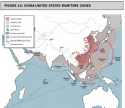Yes, but so what?
It doesn't change the analysis nor conclusion.
It does. Four Type 056A can fire a total of 16 ASMs, which is already a heavy bunch.
Yes, but so what?
It doesn't change the analysis nor conclusion.
The Type-054 and Type-052B are essentially batches of test/experimental ships. It's not an issue if they get sold off.
As a Frigate, the Type-54 isn't obsolete per se, but many of the onboard systems look like one-offs and are therefore expensive/difficult to maintain.
---
I reckon the older Type-56 will probably be refitted with the TAS and VDS, at the next convenient opportunity.
But there's no rush since there are already 50 ships which do have the TAS and VDS.
The sea is simply not flat nor featureless. It is CURVED. Because the Earth is round, don't you get it? You cannot see what would be under the ground because of it.
The sea reflects clutter to the radar. Sea waves reflect radar, and back to the receiver. This creates noise and interference. Its like the sea is an ECM blanket of its own. Naval radars have to be extensively modified from their land based counterparts because of this. Even then, on certain areas, like littoral areas things underneath the water can reflect radar back and create readings.
Why do you think stealth was developed for ships, or at least partial stealth? If you are in AEW aircraft, from a far distance and with the Earth curvature considered, the ship is actually tilted back, and isn't standing straight up. If you increase the sloped angles of the ship on the side, that further steepens the angle of deflection, given you account for the earth curvature geometry. At the same time, the radar waves of the aircraft cannot reach the hull of the ship as it is too low and obscured by the curvature. That's why you see ships like the Shandong and the Type 075 have radar deflection features on their island but didn't have to bother on the hull.
Why do you think many ships have all these long flat sides that has a creased line and angled from above the crease line? Do you think that's for aesthetics? This design feature you can see from ships in France to Russia to China and across the world. Do you think that somehow they are all wrong? Every modern warship nowadays is a practice of partial stealth, with the Type 022, both LCS and the Zumwalt edging towards a more extreme practice.
The Type 056 itself is an exercise in partial stealth, something the Chinese Navy started with the 052B, and is refining with every new design. It also has a low silhouette, so its not going to show up so quickly.
"No, the sea is essentially flat and featureless."
It does. Four Type 056A can fire a total of 16 ASMs, which is already a heavy bunch.

All these ship design features help with warships hiding yes.
But even the Zumwalt still looks like a fishing boat, as per the US Navy.
Surface ships will still be detected by airborne radars at long distances.
---
You're missing the point.
My exact words were:
We all know the oceans follow the Earth's curvature and impose a radar horizon. That is obvious.
It is the primary reason why aircraft are better at finding ships, because aircraft can fly high, and also cover long distances.
But in the real world, from the point of view of an airplane looking for enemy ships - the sea is essentially flat and featureless.
The ship has nowhere it can hide. It can look smaller with stealthy shaping, but it can't actually hide anywhere.
Here's an older map from the CBSA on the Western Pacific.
Basically Chinese bastions extend out 400km from mainland Chinese bases.
The logic is that airborne AWACs has a radar horizon of 420km+.
And that land-based SAMs have a range of 400km.
So the Chinese bastions run along:
1. All of the Bohai Sea
2. All of the Yellow Sea to the coast of South Korea,
3. Half of the East China Sea, to the 400km midpoint from Shanghai to Kyushu
4. Covering all of Taiwan
5. Then from Hainan, to Woody Island and down to the 3 bases in the South China Seas.
These are low-risk and medium-risk areas for Chinese warships.
And the high-risk (no-mans land) area are further beyond.
View attachment 56740
At the same time, if you detected a ship, how are you going to identify it? There is going to be plenty of ships in the ocean, by far, most of which are civilian and commercial. The Type 056A is a ship that is smaller than most ships in the ocean, and one that has a much lower radar return.
I should add that the kind of radar used for look down doesn't have the same range as the radar used for air to air detection.
The reason for the bastion areas is for the corvettes to protect the SSBNs. Not because you want to hide your ships.
Plus the idea that you think the Bohai Sea won't be attacked by US assets located in South Korea and Japan is ludicrisp.
